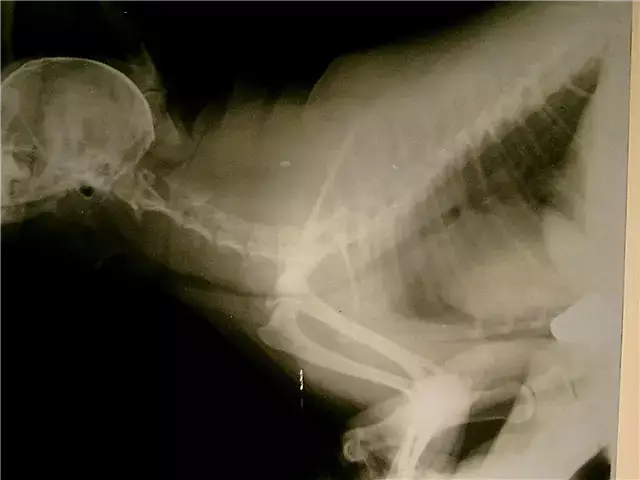- Author Rachel Wainwright [email protected].
- Public 2023-12-15 07:39.
- Last modified 2025-11-02 20:14.
Walz
Instructions for use:
- 1. Pharmacological action
- 2. Release form
- 3. Analogs
- 4. Indications for use
- 5. Method of application
- 6. Contraindications
- 7. Side effects
- 8. Storage conditions
Valz is a peripheral vasodilator used in the treatment of diseases of the cardiovascular system.
Pharmacological action Valza
According to the instructions, Walz is a peripheral vasodilator, which is a specific AT1 blocker, has a hypotensive effect and does not inhibit the angiotensin-converting enzyme.
Release form

According to the instructions, Walz is produced in the form of oval, biconvex, yellow film-coated tablets with the inscription "V" on one side, side risks and a risk on the other side, 40 mg and 160 mg each and pink tablets with the inscription "V" on one side, side risks and risks on the other hand, 80 mg in cell contour packagings. One Valza tablet contains:
- Valsartan - 40 mg (80 mg or 160 mg);
- Lactose monohydrate - 21.11 mg (42.22 mg or 84.44 mg);
- Povidone K29-32 - 3.6 mg (7.2 mg or 14.4 mg);
- Microcrystalline cellulose - 18 mg (36 mg or 72 mg);
- Croscarmellose sodium - 5.4 mg (10.8 mg or 21.6 mg);
- Talc - 0.9 mg (1.8 mg or 3.6 mg);
- Magnesium stearate - 0.63 mg (1.26 mg or 2.52 mg);
- Colloidal silicon dioxide - 0.36 mg (0.72 mg or 1.44 mg).
The film shell of Walz tablets contains opadry II 85G32407 yellow - 3.6 mg, 7.2 mg or 14.4 mg, as well as:
- Polyvinyl alcohol - 1.584 mg (3.168 mg or 6.336 mg);
- Macrogol-3350 - 0.444 mg (0.889 mg or 1.778 mg);
- Talc - 0.72 mg (1.44 mg or 2.88 mg);
- Iron oxide yellow dye - 0.128 mg (for 40 mg of yellow tablets);
- Iron oxide yellow dye - 0.029 mg and red iron oxide dye - 0.049 mg (for 80 mg of pink tablets);
- Iron oxide yellow dye - 0.910 mg and iron oxide red dye - 0.016 mg (for 160 mg of yellow tablets);
- Titanium dioxide - 0.598 mg (1.373 mg or 1.976 mg);
- Lecithin - 0.126 mg (0.252 mg or 0.504 mg).
Analogues of Valza
Valza's analogs for the active ingredient are:
- Diovan;
- Valsafors;
- Tantordio;
- Valsartan Zentiva;
- Northvan;
- Valsacor;
- Tareg.
By the mechanism of action and belonging to the same pharmacological group, the following drugs are referred to the analogs of Valza:
- Aprovel;
- Attackand;
- Blockchain;
- Brozaar;
- Vasotens;
- Zisakar;
- Ibertan;
- Irsar;
- Irbesartan;
- Losartan;
- Losacor;
- Candesar;
- Cardomin Sanovel;
- Cardosal 10;
- Kardosten;
- Karzartan;
- Lakea;
- Lozarel;
- Lotor;
- Lorista;
- MacLeods;
- Mikardis;
- Naviten;
- Priitor;
- Presartan;
- Renicard;
- Telmisartan-Richter;
- Teveten;
- Firmasta.
Indications for Valza's use
The drug Valz is prescribed for arterial hypertension and chronic heart failure. Valz is also a part of complex therapy and is used to increase the survival rate of patients with acute myocardial infarction complicated by both left ventricular systolic dysfunction and left ventricular failure.
Method of application Valza

In accordance with the instructions, Valz is taken orally with a liquid, regardless of the meal. The dosage of the drug depends on the disease, namely:
- In hypertension, the initial dose is 80 mg, with a possible increase to 160 mg once a day for 4 weeks;
- In chronic heart failure, the dose is 40 mg twice a day with a gradual increase to 80 mg;
- With stable hemodynamic parameters after myocardial infarction, the dose is 20 mg twice a day with a gradual increase to 40 mg, 80 mg and 160 mg twice a day;
- For mild and moderate liver dysfunction without the development of cholestasis, the dose is 80 mg per day.
Contraindications
In accordance with the instructions, Valz is contraindicated during pregnancy and lactation, children under the age of 18, with liver dysfunction associated with obstruction of the biliary tract, lactose intolerance, syndrome of impaired absorption of galactose and glucose, galactosemia, renal failure and hypersensitivity to the components drug.
With caution, Valz is prescribed for arterial hypotension, hypertrophic obstructive cardiomyopathy, hyponatremia, hyperkalemia, bilateral stenosis of the renal arteries or an artery of a single kidney, mitral and aortic stenosis, primary hyperaldosteronism, as well as in conditions accompanied by a decrease in circulating blood volume.
Side effects
The use of Valza according to reviews causes complications from various body systems, namely:
- Bleeding, heart failure, decreased blood pressure, orthostatic hypotension and vasculitis (cardiovascular system);
- Cough (respiratory system);
- Diarrhea, abdominal pain, and nausea (digestive system);
- Postural dizziness, fainting, insomnia, depression, decreased libido, dizziness, neuralgia, and headache (central nervous system);
- Vertigo (hearing organs and labyrinth apparatus);
- Neutropenia and thrombocytopenia (hematopoietic system);
- Back pain, arthritis, muscle cramps, myalgia and arthralgia (musculoskeletal system);
- Impaired renal function and acute renal failure (urinary system);
- Hyperkalemia (metabolism);
- Decreased hemoglobin and hematocrit, increased serum urea nitrogen, hypercreatininemia, increased hepatic transaminase activity and hyperbilirubinemia (laboratory parameters).
Also, the use of Valza according to reviews can lead to:
- Serum sickness;
- Hypersensitivity;
- Angioedema;
- Skin rash and itching;
- Viral infections;
- Upper respiratory tract infections;
- Pharyngitis;
- Sinusitis;
- Conjunctivitis;
- Rhinitis;
- Gastroenteritis;
- Feeling tired
- Asthenia;
- Nosebleeds;
- Swelling.
In cases of overdose, the use of Valza according to reviews causes a decrease in blood pressure.
Storage conditions
In accordance with the instructions, Valz must be stored out of the reach of children and protected from light in a dry place, at room temperature up to 30 ° C. The shelf life of the drug, subject to the recommendations, is 3 years.
Information about the drug is generalized, provided for informational purposes only and does not replace the official instructions. Self-medication is hazardous to health!






